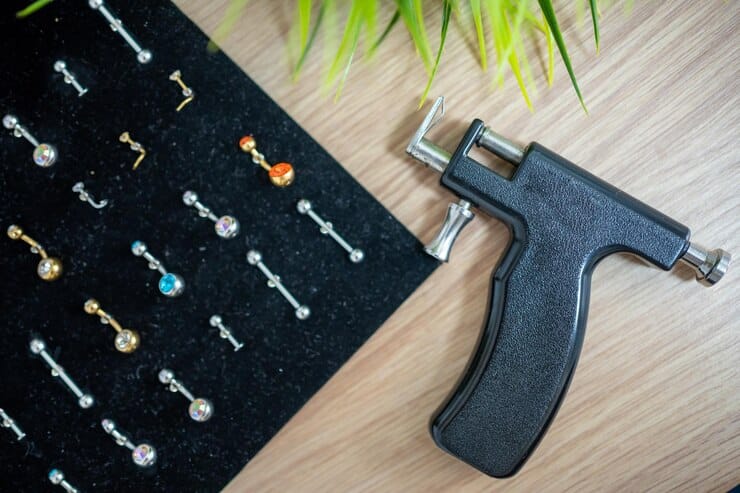If you’re thinking of getting an ear piercing, understanding the anatomy of your ear and how different piercings are done is essential. An ear piercing chart can be a beginner’s best friend in this journey. This visual guide provides information about where different types of piercings go on the unique shape of your ear. Whether you’re looking for your first lobe piercing or something more daring, like a helix position, an ear piercing chart provides all necessary guidance for making that big decision.
Types of Ear Piercings

- For piercing types are all quite beautiful in their own form. Initially, know what kinds of piercings there are so that it gets easier to select the best piercing for you.
- Lobe Piercing: Mostly found at the lower portion of the ear. This is the least painful and most common among all piercings.
- Helix piercing: It will look pretty simple yet stylish as it pierces the upper part of the ear curl cartilage. Tragus Piercing: This is a small fleshy part located right in front of the ear canal. Antitragus Piercing: Found above the lobe on the opposite side of the tragus, this is. Conch Piercing: This one is for inside ear cartilage that is shell-shaped. It’s pretty cool.
- Industrial Piercing: It is the hardest piercing of all because it goes on the top cartilage of the ear and joins two holes together through a barbell.
- Daith Piercing: It is run within the innermost fold of the cartilage in an ear, and they say it is very famous for relief from migraines.
- Rook Piercing: It’s a piercing into the upper inside cartilage of the ear, above the tragus.
Choosing the Right Piercing for You
Selecting the right piercing goes beyond the chart. Here are some things to think about:
- Personal Preferences: Do you prefer a subtle look, or are you more into bold, eye-catching piercings?
- Pain Level Considerations: Some piercings, like cartilage piercings, may be more painful than others.
- Lifestyle and Aftercare: Consider how easy it will be to care for your piercing based on your daily activities.
Piercing Chart Symbols and Notations
On a piercing chart, you could notice other symbols used for showing the different types of piercings and jewelry types. For example, dots or circles can indicate the actual spot of the piercing. An accompanying line or bar is used to inform where a barbell or hoop is normally placed. Understanding these symbols is thus very helpful in visualizing your piercing plan better.
What to Consider Before Getting Pierced

Before choosing a piercing, consider the following:
- Ear Anatomy: Make sure you understand your ear shape and size to avoid any placement issues.
- Health: Make sure you’re in good health to avoid infections or complications.
Safety and Hygiene Tips
Keeping your piercings clean is crucial to avoid infections:
- Cleanliness: Use antibacterial soap to clean your piercing.
- Avoid Swimming: Pools and hot tubs can introduce bacteria to your new piercing.
Benefits of Using an Ear Piercing Chart
Ear piercing charts can really help people who plan to pierce their ears. Pictures of the different choices help in conceiving and planning piercings, as well as in preventing mistakes. This is especially for people who would like to get multiple piercings.
Common Questions about Ear Piercing Charts

- Can I Design My Own Piercing Layout?
- Yes, with an ear piercing chart, you can mix and match piercings to create a unique design.
- How Many Piercings Can I Have in One Ear?
- It’s up to you! Some people go for a simple look with a single piercing, while others opt for multiple.
- How Do I Visualize the Pain for Each Piercing Type?
- Some charts include pain level indicators for each piercing type.
- Is It Okay to Pierce Both Ears at Once?
- It’s generally fine, but consult with your piercer to make sure it’s safe for you.
- How Do I Take Care of Multiple Ear Piercings at Once?
- Make sure to clean each piercing properly and follow the aftercare instructions for each.
Conclusion
A great ear-piercing chart will help everyone thinking about getting piercings. It will simplify the choice and greatly help visualize it. So, even though all ear piercings are good, choose those that will suit your style and your life and take great care to ensure a smooth healing process.
FAQs
Which ear piercing is the best for beginners?
Lobe piercings are the most preferred among beginners as they are straightforward and less time-consuming.
Can I pierce without a chart?
You can do so, but this helps to ensure correct placement and reduce the likelihood of error.
How can I visualize the pain for every type of piercing?
A lot of charts contain indicators of the pain levels attached to them to help understand what to expect.
Is it okay to pierce both ears at once?
Yes, but one should follow all care processes to make sure that the ear is well healed.
How do I take care of multiple ear piercings at once?
Every piercing is cleaned well, not touched at all with dirty hands, and follows the advice of the piercer.






